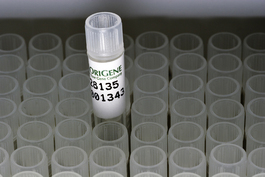SMAD2 (NM_001135937) Human Untagged Clone
CAT#: SC325924
SMAD2 (untagged)-Human SMAD family member 2 (SMAD2), transcript variant 3
"NM_001135937" in other vectors (6)
Product Images

Specifications
| Product Data | |
| Type | Human Untagged Clone |
| Tag | Tag Free |
| Symbol | SMAD2 |
| Synonyms | hMAD-2; hSMAD2; JV18; JV18-1; MADH2; MADR2 |
| Vector | pCMV6-Entry |
| E. coli Selection | Kanamycin (25 ug/mL) |
| Mammalian Cell Selection | Neomycin |
| Sequence Data |
>NCBI ORF sequence for NM_001135937, the custom clone sequence may differ by one or more nucleotides
ATGTCGTCCATCTTGCCATTCACGCCGCCAGTTGTGAAGAGACTGCTGGGATGGAAGAAGTCAGCTGGTG GGTCTGGAGGAGCAGGCGGAGGAGAGCAGAATGGGCAGGAAGAAAAGTGGTGTGAGAAAGCAGTGAAAAG TCTGGTGAAGAAGCTAAAGAAAACAGGACGATTAGATGAGCTTGAGAAAGCCATCACCACTCAAAACTGT AATACTAAATGTGTTACCATACCAAGGTCTCTTGATGGTCGTCTCCAGGTATCCCATCGAAAAGGATTGC CACATGTTATATATTGCCGATTATGGCGCTGGCCTGATCTTCACAGTCATCATGAACTCAAGGCAATTGA AAACTGCGAATATGCTTTTAATCTTAAAAAGGATGAAGTATGTGTAAACCCTTACCACTATCAGAGAGTT GAGACACCAGTTTTGCCTCCAGTATTAGTGCCCCGACACACCGAGATCCTAACAGAACTTCCGCCTCTGG ATGACTATACTCACTCCATTCCAGAAAACACTAACTTCCCAGCAGGAATTGAGCCACAGAGTAATTATAT TCCAGAAACGCCACCTCCTGGATATATCAGTGAAGATGGAGAAACAAGTGACCAACAGTTGAATCAAAGT ATGGACACAGGCTCTCCAGCAGAACTATCTCCTACTACTCTTTCCCCTGTTAATCATAGCTTGGATTTAC AGCCAGTTACTTACTCAGAACCTGCATTTTGGTGTTCGATAGCATATTATGAATTAAATCAGAGGGTTGG AGAAACCTTCCATGCATCACAGCCCTCACTCACTGTAGATGGCTTTACAGACCCATCAAATTCAGAGAGG TTCTGCTTAGGTTTACTCTCCAATGTTAACCGAAATGCCACGGTAGAAATGACAAGAAGGCATATAGGAA GAGGAGTGCGCTTATACTACATAGGTGGGGAAGTTTTTGCTGAGTGCCTAAGTGATAGTGCAATCTTTGT GCAGAGCCCCAATTGTAATCAGAGATATGGCTGGCACCCTGCAACAGTGTGTAAAATTCCACCAGGCTGT AATCTGAAGATCTTCAACAACCAGGAATTTGCTGCTCTTCTGGCTCAGTCTGTTAATCAGGGTTTTGAAG CCGTCTATCAGCTAACTAGAATGTGCACCATAAGAATGAGTTTTGTGAAAGGGTGGGGAGCAGAATACCG AAGGCAGACGGTAACAAGTACTCCTTGCTGGATTGAACTTCATCTGAATGGACCTCTACAGTGGTTGGAC AAAGTATTAACTCAGATGGGATCCCCTTCAGTGCGTTGCTCAAGCATGTCATAA |
| Restriction Sites | SgfI-MluI |
| ACCN | NM_001135937 |
| OTI Disclaimer | Our molecular clone sequence data has been matched to the reference identifier above as a point of reference. Note that the complete sequence of our molecular clones may differ from the sequence published for this corresponding reference, e.g., by representing an alternative RNA splicing form or single nucleotide polymorphism (SNP). |
| OTI Annotation | This TrueClone is provided through our Custom Cloning Process that includes sub-cloning into OriGene's pCMV6 vector and full sequencing to provide a non-variant match to the expected reference without frameshifts, and is delivered as lyophilized plasmid DNA. |
| Product Components | The cDNA clone is shipped in a 2-D bar-coded Matrix tube as dried plasmid DNA. The package also includes 100 pmols of both the corresponding 5' and 3' vector primers in separate vials. Every lot of primer is tested to provide clean sequencing of OriGene TrueClones. |
| Reconstitution | 1. Centrifuge at 5,000xg for 5min. 2. Carefully open the tube and add 100ul of sterile water to dissolve the DNA. 3. Close the tube and incubate for 10 minutes at room temperature. 4. Briefly vortex the tube and then do a quick spin (less than 5000xg) to concentrate the liquid at the bottom. 5. Store the suspended plasmid at -20°C. The DNA is stable for at least one year from date of shipping when stored at -20°C. |
| Reference Data | |
| RefSeq | NM_001135937.2, NP_001129409.1 |
| RefSeq Size | 10461 bp |
| RefSeq ORF | 1314 bp |
| Locus ID | 4087 |
| Cytogenetics | 18q21.1 |
| Protein Families | Cancer stem cells, Druggable Genome, Embryonic stem cells, ES Cell Differentiation/IPS, Stem cell relevant signaling - JAK/STAT signaling pathway, Stem cell relevant signaling - TGFb/BMP signaling pathway, Transcription Factors |
| Protein Pathways | Adherens junction, Cell cycle, Colorectal cancer, Pancreatic cancer, Pathways in cancer, TGF-beta signaling pathway, Wnt signaling pathway |
| Gene Summary | 'The protein encoded by this gene belongs to the SMAD, a family of proteins similar to the gene products of the Drosophila gene 'mothers against decapentaplegic' (Mad) and the C. elegans gene Sma. SMAD proteins are signal transducers and transcriptional modulators that mediate multiple signaling pathways. This protein mediates the signal of the transforming growth factor (TGF)-beta, and thus regulates multiple cellular processes, such as cell proliferation, apoptosis, and differentiation. This protein is recruited to the TGF-beta receptors through its interaction with the SMAD anchor for receptor activation (SARA) protein. In response to TGF-beta signal, this protein is phosphorylated by the TGF-beta receptors. The phosphorylation induces the dissociation of this protein with SARA and the association with the family member SMAD4. The association with SMAD4 is important for the translocation of this protein into the nucleus, where it binds to target promoters and forms a transcription repressor complex with other cofactors. This protein can also be phosphorylated by activin type 1 receptor kinase, and mediates the signal from the activin. Alternatively spliced transcript variants have been observed for this gene. [provided by RefSeq, May 2012]' Transcript Variant: This variant (3, also known as SMAD2Deltaexon3) lacks an in-frame exon in the 5' coding region, compared to variant 2, resulting in an isoform (2) that is shorter than isoform 1. There are no publicly available full-length transcripts representing this variant, but it is supported by data in Taekenoshita et al. (1998; PMID: 9503010) and Yagi et al. (1999; PMID: 9873005). Sequence Note: This RefSeq record was created from transcript and genomic sequence data to make the sequence consistent with the reference genome assembly. The genomic coordinates used for the transcript record were based on transcript alignments. |
Documents
| Product Manuals |
| FAQs |
Resources
Other Versions
| SKU | Description | Size | Price |
|---|---|---|---|
| RC226623 | SMAD2 (Myc-DDK-tagged)-Human SMAD family member 2 (SMAD2), transcript variant 3 |
USD 420.00 |
|
| RG226623 | SMAD2 (GFP-tagged) - Human SMAD family member 2 (SMAD2), transcript variant 3 |
USD 460.00 |
|
| RC226623L1 | Lenti-ORF clone of SMAD2 (Myc-DDK-tagged)-Human SMAD family member 2 (SMAD2), transcript variant 3 |
USD 768.00 |
|
| RC226623L2 | Lenti-ORF clone of SMAD2 (mGFP-tagged)-Human SMAD family member 2 (SMAD2), transcript variant 3 |
USD 620.00 |
|
| RC226623L3 | Lenti-ORF clone of SMAD2 (Myc-DDK-tagged)-Human SMAD family member 2 (SMAD2), transcript variant 3 |
USD 620.00 |
|
| RC226623L4 | Lenti-ORF clone of SMAD2 (mGFP-tagged)-Human SMAD family member 2 (SMAD2), transcript variant 3 |
USD 620.00 |
{0} Product Review(s)
Be the first one to submit a review






























































































































































































































































 Germany
Germany
 Japan
Japan
 United Kingdom
United Kingdom
 China
China
